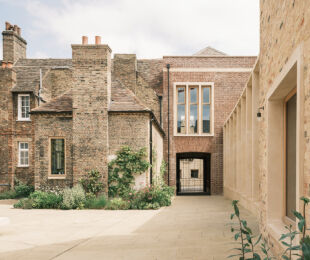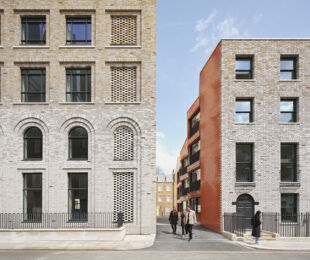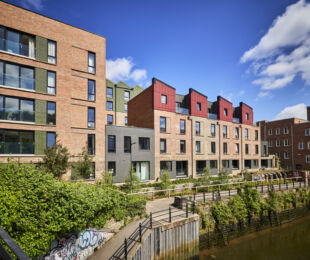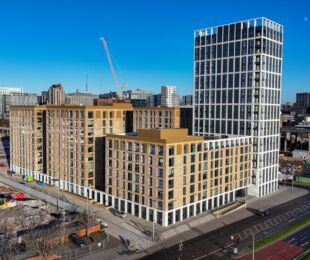
Excelsior Works is a collection of 108, 1 and 2-bedroom apartments in what was Manchester's industrial centre, designed by Tim Groom Architects, it also features a communal roof garden and a basement car park. The building occupies a plot left vacant after the derelict printing mill that was there previously was demolished in 2015. Excelsior Works incorporates Michelmersh Charnwood Dark Red Handmade bricks and each brick was stamped with the makers initials. Brick was used to retain the heritage of the area and the deep tones of the Dark Red bricks was perfect for this.
Excelsior Works overlooks the Bridgewater Canal and offers easy access to the centre of Manchester. Various call-backs to its history are dotted throughout the structure, ensuring that it's rich industrial heritage will not be forgotten. The client’s brief was to design a residential scheme with a mix of one, two and three-bedroom apartments for individual private sale. Occupying the site of a former bookbinding works and sitting on the periphery of the Castlefield Conservation Area, the Client was keen for the scheme to pay tribute to both the site, and City’s industrial past. Withstanding the challenging constraints of the site, the Client wanted the architect to augment views for residents and provide a scheme perceived as the vanguard of the area’s new masterplan. The construction programme commenced May 2018 and completed February 2020.
It occupies a pronounced location on the corner of Hulme Hall Road and converges upon a change in topography along the Bridgewater Canal. Our aim was to design a building that celebrates the area’s history and utilises the Site’s views along the canal. By virtue of its location and its position amongst rhythmic façades of neighbouring buildings, the Scheme perceives its historic heritage through its form and detailing of the façade.
The site’s relationship at canal towpath level was previously underutilised and other built schemes along this stretch had turned their backs on the canal. The Local Planning Authority wanted to reverse this scenario and “readdress the canal”. This steep stretch of canal was previously unavailable to wheelchair users. Consequently, the scheme now has the unique advantage of being able to be accessed from two separate levels – via the canal towpath and by the main road.
There were numerous site constraints, including listed buildings, listed party walls, canal inlet and towpath. The close proximity of adjoining properties and no building works access from most sides meant that fully scaffolding the elevations was impractical. This contributed to a very challenging programme and budget sought by the Client, meaning the architects were instrumental in the construction methodology discussions pre-novation.
The conclusion of this construction methodology was precast panels, with the majority of the building elevations being manufactured off-site. Masonry and windows were installed in-situ and panels were carefully designed to limit transport to site and ensure efficient tower crane usage. To preserve the design approved at planning it was vital the architect upheld a refined palette of materials. The challenges were to incorporate a handmade, high-quality textured brick befitting to the context, that could be used as a mould, able to be cast in the precast concrete. Each brick was specifically hand thrown with the Maker’s initials stamped, drawing parallels to the site’s history as a printing and bookbinding works.
The materiality and detailing were subject to several large-scale sample panels which also included the precast manufacturer exploring a new sand sealant technology to avoid the appearance of thick movement joins engulfing the building. The precast allowed for several different levels of brick recesses, with the façade reflecting the order of a letterpress printing tray. The scheme proudly reconciles its heritage and the introduction of laser cut text on metal panels at both site entrances are a further reminder of this.






